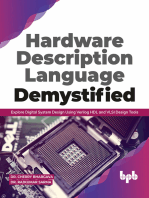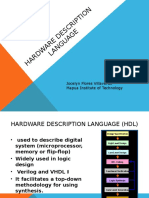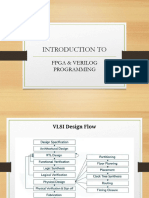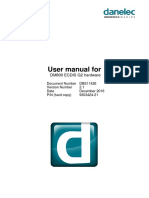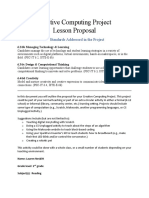Hardware Descriptive Language
Uploaded by
ShayneMayoresHardware Descriptive Language
Uploaded by
ShayneMayores1.What is Hardware Descriptive Language?
Hardware description languages (HDLs) are extremely important tools for modern digital
designers. Once you have learned System, Verilog or VHDL, you will be able to specify digital systems
much faster than if you had to draw the complete schematics. The debug cycle is also often much faster,
because modifications require code changes instead of tedious schematic rewiring. However, the debug
cycle can be much longer using HDLs if you don't have a good idea of the hardware your code implies.
HDLs are used for both simulation and synthesis. Logic simulation is a powerful way to test a
system on a computer before it is turned into hardware. Simulators let you check the values of signals
inside your system that might be impossible to measure on a physical piece of hardware. Logic
synthesis converts the HDL code into digital logic circuits.
2. What are the three (3) common Hardware Descriptive Language? Differentiate each type.
The three common HDLs are Verilog, VHDL and System C. VHDL and Verilog are considered
general-purpose digital design languages, while System Verilog represents an enhanced version of
Verilog.
VHDL is a rich and strongly typed language, deterministic and more verbose than Verilog. As a result,
designs written in VHDL are considered self-documenting. Its syntax is non-C-like and engineers
working in VHDL need to do extra coding to convert from one data type to another. VHDL often
catches errors missed by Verilog. VHDL emphasizes unambiguous semantics and allows portability
between tools.
Sample VHDL Code:
reg1: process (rst, clk)
begin
if rst = '1' then
q_reg <= (others => '0');
q_i <= (others => '0');
elsif rising_edge(clk) then
if s_l = '1' then
q_i(0) <= q_i(7);
loop1: for i in 6 downto 0 loop
q_i(i + 1) <= q_i(i);
end loop loop1;
q_reg <= y;
else
q_i <= q_reg;
q_reg <= y;
end if;
end if;
end process reg1;
Verilog is weakly typed and more concise with efficient notation. It is deterministic. All data types
are predefined in Verilog and each has a bit-level representation. Syntax is C-like.
Sample Verilog Code
always @(posedge CLK or posedge RST)
begin
if (RST) begin
q_reg = 0;
Q = 0;
end else if (S_L) begin
Q[7:0] = {Q[6:0],Q[7]};
q_reg = Y;
end else begin
Q = q_reg;
q_reg = Y;
end
end
System Verilog or SystemC includes a set of extensions to the Verilog HDL to help engineers design
and verify larger and more complex designs. In fact, many industry watchers consider it the first
Hardware Description and Verification Language (HDVL), because it combines VHDL and Verilog
features with those of Hardware Verification Languages (HVLs) Vera and e, as well as C and C++. It’s
targeted at RTL coding, using constrained random techniques for assertion-based and coverage-
driven verification.
Sample SystemVerilog Code:
property p_push_error;
@ (posedge clk)
not (b_if.push && b_if.full && !b_if.pop);
endproperty : p_push_error
ap_push_error_1 : assert property (p_push_error);
property p_pop_error;
@ (posedge clk)
not (b_if.pop && b_if.empty);
endproperty : p_pop_error
ap_pop_error_1 : assert property (p_pop_error);
always_ff @ (posedge clk) begin
b_if.error <= (b_if.pop && b_if.empty) || (b_if.push && b_if.full && !b_if.pop);
3. How does hardware description language work?
Hardware description languages allow you to describe a circuit using words and symbols, and
then development software can convert that textual description into configuration data that is loaded
into the FPGA in order to implement the desired functionality.
References:
https://www.sciencedirect.com/topics/computer-science/hardware-description-languages?
fbclid=IwAR2VyvHwge_n9TxuwfHOXBH0RBhf4JARC19Y_xGQumvvtbWcO2lowuU9JD4
https://www.electronicdesign.com/resources/whats-the-difference-between/article/21800239/whats-
the-difference-between-vhdl-verilog-and-systemverilog
https://www.allaboutcircuits.com/technical-articles/what-is-a-hardware-description-language-hdl/?
fbclid=IwAR1Ir3r8cAT_tp9j0RCDhGuBqwnicAACD1bEmFutyDLIIT7LHAf5jEf7kcM
You might also like
- All V Rising Console Commands and Cheat Codes - GamesRadar+No ratings yetAll V Rising Console Commands and Cheat Codes - GamesRadar+1 page
- Hardware Description Language Demystified: Explore Digital System Design Using Verilog HDL and VLSI Design ToolsFrom EverandHardware Description Language Demystified: Explore Digital System Design Using Verilog HDL and VLSI Design ToolsNo ratings yet
- Presentation ASIC Programming: By, Nayan Prajapati (10MEEC13) Rakesh Prajapati (10MEEC14) MEEC, Sem-I, KIT&RC100% (1)Presentation ASIC Programming: By, Nayan Prajapati (10MEEC13) Rakesh Prajapati (10MEEC14) MEEC, Sem-I, KIT&RC20 pages
- Computer-Based Project in VLSI Design Co 3/8: Hardware Description Language VHDLNo ratings yetComputer-Based Project in VLSI Design Co 3/8: Hardware Description Language VHDL8 pages
- Module - 5 Introduction To VHDL 5.1: ObjectivesNo ratings yetModule - 5 Introduction To VHDL 5.1: Objectives14 pages
- Digital Design Using Verilog HDL: Fall 21No ratings yetDigital Design Using Verilog HDL: Fall 2139 pages
- Hardware Description Language or HDL Is Any Language From A Class ofNo ratings yetHardware Description Language or HDL Is Any Language From A Class of11 pages
- Swift Programming Simplified: A Practical Guide with ExamplesFrom EverandSwift Programming Simplified: A Practical Guide with ExamplesNo ratings yet
- C++ Regular Expressions Simplified: A Practical Guide with ExamplesFrom EverandC++ Regular Expressions Simplified: A Practical Guide with ExamplesNo ratings yet
- Python Advanced Programming: The Guide to Learn Python Programming. Reference with Exercises and Samples About Dynamical Programming, Multithreading, Multiprocessing, Debugging, Testing and MoreFrom EverandPython Advanced Programming: The Guide to Learn Python Programming. Reference with Exercises and Samples About Dynamical Programming, Multithreading, Multiprocessing, Debugging, Testing and MoreNo ratings yet
- C++ Debugging from Scratch: A Practical Guide with ExamplesFrom EverandC++ Debugging from Scratch: A Practical Guide with ExamplesNo ratings yet
- Playnetwork Media Player: Installation & User ManualNo ratings yetPlaynetwork Media Player: Installation & User Manual16 pages
- JNORTH Maths GR12 March 2022 QP and MemoNo ratings yetJNORTH Maths GR12 March 2022 QP and Memo27 pages
- Cambridge International AS & A Level: Computer Science 9618/41No ratings yetCambridge International AS & A Level: Computer Science 9618/4112 pages
- API-1165 Compliance - Brochure - SE-LIO-OASySDNA - 04-18No ratings yetAPI-1165 Compliance - Brochure - SE-LIO-OASySDNA - 04-183 pages
- 3.6 "Main Radar Error"&"Aided Radar Error": Headway VDR/S-VDR Operation ManualNo ratings yet3.6 "Main Radar Error"&"Aided Radar Error": Headway VDR/S-VDR Operation Manual1 page
- ShopSmart - An Innovative Shopping Trolley For Safe DistancingNo ratings yetShopSmart - An Innovative Shopping Trolley For Safe Distancing6 pages
- Click On Cost Explorer To Get Monthly EC2 Running Hours, Costs, and UsageNo ratings yetClick On Cost Explorer To Get Monthly EC2 Running Hours, Costs, and Usage6 pages
- The 2020 Data Connectivity Survey: by David Loshin, Knowledge Integrity, IncNo ratings yetThe 2020 Data Connectivity Survey: by David Loshin, Knowledge Integrity, Inc36 pages
- PDF Contoh Soal Transformasi Laplace Dan JawabandocxNo ratings yetPDF Contoh Soal Transformasi Laplace Dan Jawabandocx26 pages
- Analog Style VU Meter On OLED Display - Arduino CompatibleNo ratings yetAnalog Style VU Meter On OLED Display - Arduino Compatible5 pages
- Hash Function: Message Digest or Simply Hash ValuesNo ratings yetHash Function: Message Digest or Simply Hash Values20 pages
- ANN Prediction of Formation Bulk Density PresentationNo ratings yetANN Prediction of Formation Bulk Density Presentation20 pages
- DLD Lab: Introduction To VHDL (Very High Speed Integrated Circuit Hardware Description Language)No ratings yetDLD Lab: Introduction To VHDL (Very High Speed Integrated Circuit Hardware Description Language)30 pages
- Creative Computing Project Lesson ProposalNo ratings yetCreative Computing Project Lesson Proposal5 pages
- Setting Up (53M) : ABAP Core Data Services Extraction For SAP Data IntelligenceNo ratings yetSetting Up (53M) : ABAP Core Data Services Extraction For SAP Data Intelligence16 pages
- Technical Documentation in Software Development: Types and Tools - AltexSoftNo ratings yetTechnical Documentation in Software Development: Types and Tools - AltexSoft28 pages
- Jabra Elite 85h User Manual - EN - English - RevCNo ratings yetJabra Elite 85h User Manual - EN - English - RevC25 pages

